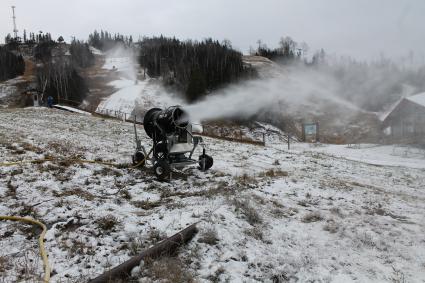Lake Superior to Lutsen Mountains waterline ready for snowmaking
The water line that runs from Lake Superior to Lutsen Mountains to provide water for snowmaking operations at the ski hill has been in the news in years past. Questions have been raised again recently when it appeared there were some new problems with the pumphouse and pipe. There were also questions of whether the waterline will be sufficient if the U.S. Forest Service gives its approval for a special use permit for a proposed ski hill expansion.
WTIP’s Rhonda Silence reached out to Lutsen Mountains for answers to those questions, as well as for a reminder of how the pipeline from Lake Superior to the ski hill came to be. In November 2011, the Minnesota Department of Natural Resources (DNR) told Lutsen Mountains that it had to stop drawing water from the Poplar River for snowmaking by October 2016.
Lutsen Mountains Co-President Tom Rider told WTIP the actual construction for the waterline started in October 2013.
It was a complicated project made more so when the firm hired to do the work went out of business. And the project made news in September 2014, when the company pulled out for the season, leaving behind one of the 200-foot-long, three-foot diameter pipe sections on shore, partially in the water. A major storm hit and waves washed the huge pipe into Lake Superior. It was later retrieved from the lake and taken by barge to Taconite Harbor, where it waited to be re-installed the next spring.
Unfortunately, problems were also discovered at the pump house that houses the equipment to feed the pipeline—three pumps, 450 horsepower each and two small 50 horsepower pumps. To connect with the large pipe going out into Lake Superior, it was necessary to dig the foundation of the pump house 30 feet into the ground. In June 2014, cracks were noticed in the foundation and the construction of the pump house was not only halted, but it also had to start all over with removal of the concrete footings and the building in progress.
Lutsen Mountains and its waterline partners-- Cook County/Grand Marais Economic Development Authority (EDA) and Superior National at Lutsen golf course; Caribou Highlands Lodge; Lutsen Resort on Lake Superior; Mountain Inn; Village at Lutsen Mountain Condominium Association; Eagle Ridge Resort; Papa Charlie’s Restaurant, and several other businesses were relieved when the $1.3 million project was completed. The waterline project also received approximately $3.6 million in state bonding.
The first full year of use of the waterline was in 2017-2018. In addition to snowmaking, water drawn from Lake Superior will be used for irrigation of Superior National at Lutsen golf course, as a water source for local fire departments, and eventually for drinking water. However, additional funds are needed to complete the water plant and drinking water phase of the project.
However, an unforeseen problem occurred in March 2018, when algae plugged the pipeline. Rider said that was unexpected as Lake Superior is considered an “oligotrophic” lake, which means it does not produce a great deal of algae. Rider said the pipeline needed a bit of engineering to prevent that from happening, but said the waterline worked well once that was done.
Asked about current problems, Rider said those had been taken care of as well. He said the waterline became plugged by sand in the inlet pipe and the vault in the pumphouse. A contractor who specializes in mining operations was hired to work in the vault which is 30 feet under the ground, as well as out in Lake Superior.
Rider said it was a pretty significant project, but he said it worked out. He said it seems that this will be an ongoing maintenance matter, something that may need to be done every three or four years. He said the problem is resolved and will not delay snowmaking operations. It is not known yet how much snow can be made before the anticipated opening of skiing on Thanksgiving, but Rider believes there will be some terrain with snow by that time.
WTIP asked Rider about the ski hill’s request to the U.S. Forest Service for a special use permit to expand onto approximately 500 acres of federal land adjacent to the current ski hill. Will the current waterline be sufficient for additional ski runs? Rider said yes, adding that the expansion plans include the construction of retention ponds. He said the existing system would fill big ponds to hold water. The design of these retention ponds can be seen in the US Forest Service draft environmental impact statement.
Asked for final thoughts on all this, Rider noted that an interesting discovery came about after the ski hill started drawing water from Lake Superior. He said the snow is much whiter from the lake than from the Poplar River which is tannic, or tea-colored. He also said the snow made from Lake Superior water “skis better and is much more durable."
Tweet







